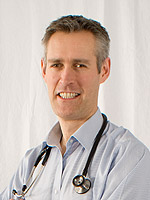Dr Quinnell is a consultant respiratory and sleep disorders physician.
He is lead consultant for Royal Papworth Hospital’s Respiratory Support and Sleep Centre (RSSC), one of the largest of its kind in the UK.
Dr Quinnell specialises in disorders of ventilation and their treatment with domiciliary ventilatory support.
He has also undergone extensive training in sleep medicine in the UK and Australia, and is an accredited sleep physician. He investigates and treats patients presenting with a wide range of respiratory and non-respiratory sleep disorders.
Longterm domiciliary ventilation, weaning from invasive ventilation and respiratory and non-respiratory sleep disorders.
Genetics and electrophysiological aspects of Narcolepsy
Chief investigator for NIHR HTA funded Trial Of Mandibular Advancement Devices in Obstructive Sleep Apnoea (TOMADO).
Member of ORANGE: International Mandibular Advancement Device Research Network
Non-invasive ventilation in Chronic Obstructive Pulmonary Disease.
Intraocular pressure during sleep.
Rapid Eye Movement sleep behaviour disorder
Atrial fibrillation in Obstructive Sleep Apnoea
1987-1993 - Royal London Hospital Medical College, Univ. Lond.
1990 - B.Sc(Hons) History of Medicine - UCL & Wellcome Inst.
1993 - MB BS
2002 - Fellow Royal Australasian College of Physicians - Accredited Sleep & Respiratory physician
2008 - Fellow Royal College of Physicians
2010 - MD, University of London
Fellow of the Royal College of Physicians, London
Fellow of the Royal Australasian College of Physicians
Member of General Medicine Council (registration number: 4024198)
Member of British Thoracic Society
Member of British Sleep Society
Member of Thoracic Society of Australasia and New Zealand
Member of Australasian Sleep Association
Quinnell T, Smith IE. Obstructive Sleep Apnoea in the Elderly: Recognition and Management Considerations. Drugs Aging 2004; 21: 307-322
Smith IE, Quinnell T. Pharmacotherapies for obstructive sleep apnoea: Where are we now? Drug 2004; 64:1385-99
Teichtahl H, Wang D, Cunnington D, Quinnell T, Tran H, Kronborg I, Drummer OH. Ventilatory responses to hypoxia and hypercapnia in stable methadone maintenance treatment patients. Chest 2005; 128: 1339-47
Quinnell T, Pilsworth S, Shneerson JM, Smith IE. Prolonged invasive ventilation following acute ventilatory failure in chronic obstructive disease: weaning results, survival and the role of non-invasive ventilation. Chest 2006;129: 133-9
Quinnell T, Farooqi IS, Smith IE, Shneerson JM. Screening the human prepro-hypocretin gene in a single-centre narcolepsy cohort. Sleep Med 2007; 8:498-502
Oscroft N, Smith IE, Quinnell T. The Role of Non-Invasive Ventilation in Weaning Patients from Invasive Ventilation. In: Yearbook of non-invasive mechanical ventilation 2008. Esquinas-Rodriguez AM, Editor. Fotomecanica Indalo, Almeria, Spain; pp 200-4
Oscroft NS, Quinnell TG, Shneerson JM, Smith IE. The effects of withdrawing long-term nocturnal non-invasive ventilation in COPD patients. Journal of Chronic Obstructive Pulmonary Disease 2010; 7: 111-116
Oscroft NS, Quinnell TG, Shneerson JM, Smith IE. Long-term non-invasive ventilation to manage persistent ventilatory failure after COPD exacerbation. Respirology 2010;15:818-22
Quinnell TG, Smith IE. Narcolepsy, idiopathic hypersomnolence and related conditions. Clinical Medicine 2011; 11: 282-5
Smith IE, Quinnell TG. Obstructive sleep apnoea: relevance to non-sleep clinicians. Clinical Medicine 2011; 11: 286-9

